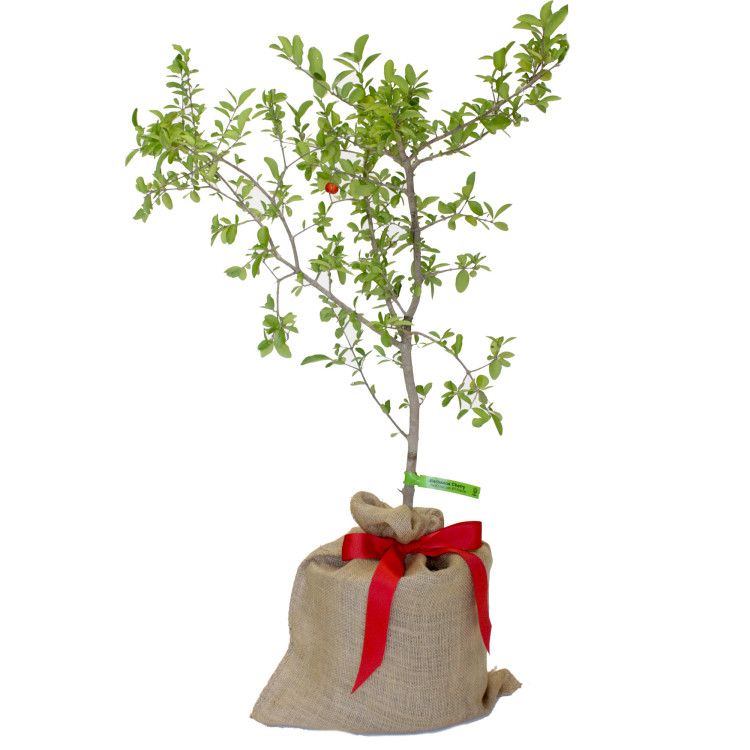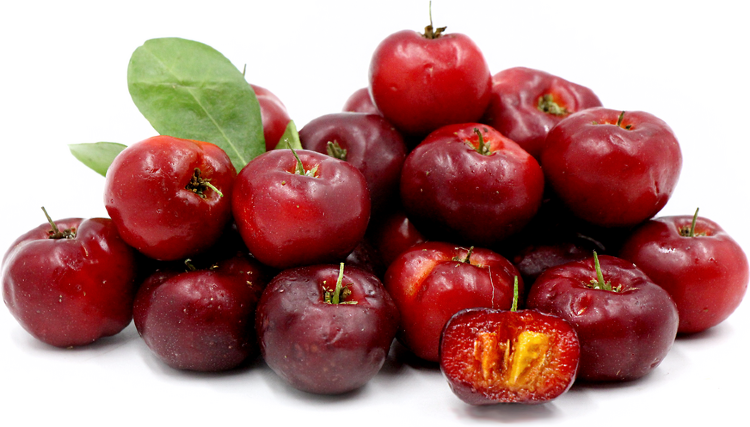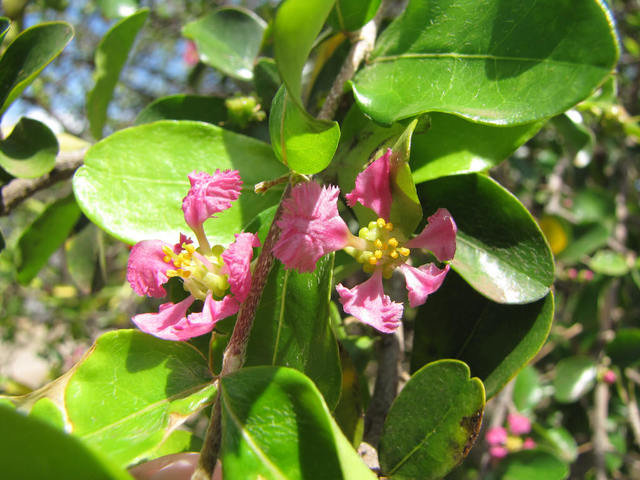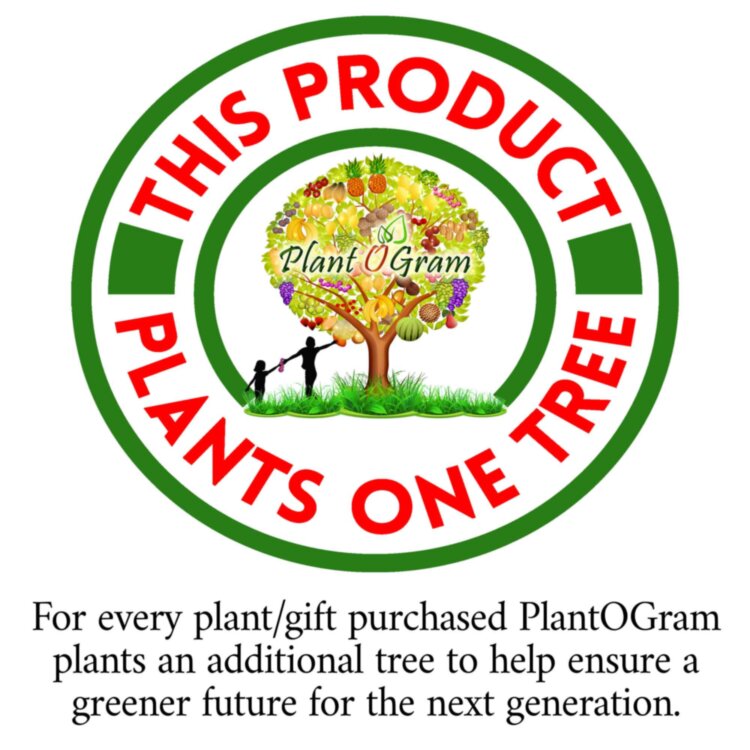- Overview
Common name: Barbados-Cherry, Acerola Botanical name: Malpighia punicifolia, M. glabra Family: Malpighiaceae Avg Height X Width: 12' x 12' Origin: West Indies, Central America Season: May-Nov. Sparsely most of the year. Damage temp: 28 F Barbados Cherry/Acerola/Guyana Cherry Tree in a 3 Gallon Container. The Barbados Cherry is a fast growing bushy tree that can be trained as a standard or shaped as a hedge. The fruit are sweet to sub-acid, and they are used extensively in juices throughout Latin America. The cherries are extremely high in Vitamin C, and just one is equal to 100% your daily allowance of Vitamin C, per 100grams 24 times the vitamin C of an Orange. They are also used in jellies, jams, and they freeze without losing their Vitamin C content. They also fruit constantly throughout the warm months, usually 8-10 months of the year so you get a lot of fruit. Also makes a great container plant for a people living in an apartment/condo or up North.
Description
Origin and Distribution
Varieties
Climate
Soil
Propagation
Culture
Pollination and Fruit Set
Season
Harvesting
Yield
Keeping Quality
Pests and Diseases
Food Uses
Food Value
Other Uses
Medicinal Uses
The Barbados cherry, a member of the Malpighiaceae, is an interesting example of a fruit that rose, like Cinderella, from relative obscurity about 40 years ago. It was at that time the subject of much taxonomic confusion, having been described and discussed previously under the binomial Malpighia glabra L., which properly belongs to a wild relative inhabiting the West Indies, tropical America and the lowlands of Mexico to southern Texas, and having smaller, pointed leaves, smaller flowers in peduncled umbels, styles nearly equal, and smaller fruits. M. Punicifolia L. (M. glabra Millsp. NOT Linn.) has been generally approved as the correct botanical name for the Barbados cherry, which is also called West Indian cherry, native cherry, garden cherry, French cherry; in Spanish, acerola, cereza, cereza colorada, cereza de la sabana, or grosella; in French, cerisier, cerise de St. Domingue; in Portuguese, cerejeira. The name in Venezuela is semeruco, or cemeruco; in the Netherlands Antilles, shimarucu; in the Philippines, malpi (an abbreviation of the generic name).
Description
rn The Barbados cherry is a large, bushy shrub or small tree attaining up to 20 ft (6 m) in height and an equal breadth; with more or less erect or spreading and drooping, minutely hairy branches, and a short trunk to 4 in (10 cm) in diameter. Its evergreen leaves are elliptic, oblong, obovate, or narrowly oblanceolate, somewhat wavy, 3/4 to 2 3/4 in (2-7 cm) long, 3/8 to 1 5/8 in (9.5-40 mm) wide, obtuse or rounded at the apex, acute or cuneate at the base; bearing white, silky, irritating hairs when very young; hairless, dark green, and glossy when mature. The flowers, in sessile or short-peduncled cymes, have 5 pink or lavender, spoon-shaped, fringed petals. The fruits, borne singly or in 2's or 3's in the leaf axils, are oblate to round, cherry-like but more or less obviously 3-lobed; 1/2 to 1 in (1.25-2.5 cm) wide; bright-red, with thin, glossy skin and orange-colored, very juicy, acid to subacid, pulp. The 3 small, rounded seeds each have 2 large and 1 small fluted wings, thus forming what are generally conceived to be 3 triangular, yellowish, leathery-coated, corrugated inedible "stones".
Origin and Distribution
The Barbados cherry is native to the Lesser Antilles from St. Croix to Trinidad, also Curacao and Margarita and neighboring northern South America as far south as Brazil. It has become naturalized in Cuba, Jamaica and Puerto Rico after cultivation, and is commonly grown in dooryards in the Bahamas and Bermuda, and to some extent in Central and South America. The plant is thought to have been first brought to Florida from Cuba by Pliny Reasoner because it appeared in the catalog of the Royal Palm Nursery for 1887-1888. It was carried abroad rather early for it is known to have borne fruit for the first time in the Philippines in 1916. In 1917, H.M. Curran brought seeds from Curacao to the United States Department of Agriculture. (S.P.I. #44458). The plant was casually grown in southern and central Florida until after World War II when it became more commonly planted. In Puerto Rico, just prior to that war, the Federal Soil Conservation Department planted Barbados cherry trees to control erosion on terraces at the Rio Piedras Experiment Station. During the war, 312 seedlings from the trees with the largest and most agreeably-flavored fruits were distributed to families to raise in their Victory Gardens. Later, several thousand trees were provided for planting in school yards to increase the vitamin intake of children, who are naturally partial to the fruits. An explosion of interest occurred as a result of some food analyses being conducted at the School of Medicine, University of Puerto Rico, in Rio Piedras in 1945. The emblic (Emblica officinalis L.) was found to be extremely high in ascorbic acid. This inspired one of the laboratory assistants to bring in some Barbados cherries which the local people were accustomed to eating when they had colds. These fruits were found to contain far more ascorbic acid than the emblic, and, because of their attractiveness and superior eating quality, interest quickly switched from the emblic to the Barbados cherry. Much publicity ensued, featuring the fruit under the Puerto Rican name of acerola. A plantation of 400 trees was established at Rio Piedras in 1947 and, from 1951 to 1953, 238 trees were set out at the Isabela Substation. By 1954, there were 30,000 trees in commercial groves on the island. Several plantings had been made in Florida and a 2,000-acre (833-ha) plantation in Hawaii. There was a great flurry of activity. Horticulturists were busy making selections of high-ascorbic-acid clones and improving methods of vegetative propagation, and agronomists were studying the effects of cultural practices. Smaller plantings were being developed in Jamaica, Venezuela, Guatemala, Ghana, India, the Philippines and Queensland, Australia, and even in Israel. Many so-called "natural food" outlets promoted various "vitamin C" products from the fruits–powder, tablets, capsules, juice, sirup. At length, enthusiasm subsided when it was realized that a fruit could not become a superstar because of its ascorbic acid content alone; that ascorbic acid from a natural source could not economically compete with the much cheaper synthetic product, inasmuch as research proved that the ascorbic acid of the Barbados cherry is metabolized in a manner identical to the assimilation of crystalline ascorbic acid. The large plantation of the Hawaiian Acerola Company (a subsidiary of Nutrilite Products Company) was abandoned for this reason, and low fruit yields; and, so it is said, the low ascorbic acid content because of the high copper levels in the soil. Puerto Rican production was directed thereafter mainly to the use of the fruit in specialty baby foods. Frozen fruits are shipped to the United States for processing.
Varieties
rn In 1956, workers at the University of Florida's Agricultural Research and Education Center in Homestead, after making preliminary evaluations and selections, chose as superior and named the 'Florida Sweet', a clone that was observed to have an upright habit of growth, large fruits, thick skin, apple-like, semi-sweet flavor, and high yield. The first promising selections in Puerto Rico, on the bases of fruit size, yield and vitamin content, were identified as 'A-l' and 'B-17', but these were later found to be inferior to 'B-15' in ascorbic acid level and productivity. Yields of 10 clones ('A-l', 'A-2', 'A-4', 'A-10', 'A-21', 'B-2', 'B-9', 'B-15', 'B-17', and 'K-7') were compared over a 2-year period (1955-56) in Puerto Rico and 'B-15' far exceeded the others in both years. A horticultural variety in St. Croix, formerly known as M. thompsonii Britton & Small, has displayed unusually large leaves and fruits and more abundant flowers than the common strain of Barbados cherry.
Climate
The Barbados cherry can be classed as tropical and subtropical, for mature trees can survive brief exposure to 28º F (-2.22º C). Young plants are killed by any drop below 30º F (-1.11º C). It is naturally adapted to both medium- and low-rainfall regions; can tolerate long periods of drought, though it may not fruit until the coming of rain.
Soil
The tree does well on limestone, marl and clay, as long as they are well drained. The pH should be at least 5.5. Elevation to 6.5 significantly improves root development. Acid soils require the addition of lime to avoid calcium deficiency and increase yield. The lime should be worked into the soil to a depth of 8 in (20 cm) or more.
Propagation
rn If seeds are used for planting, they should be selected from desirable clones not exposed to cross-pollination by inferior types. They should be cleaned, dried, and dusted with a fungicide. It should also be realized that the seeds in an individual fruit develop unevenly and only those that are fully developed when the fruit is ripe will germinate satisfactorily. Germination rates may be only 50% or as low as 5%. Seedlings should be transferred from flats to containers when 2 to 3 in (5-7.5 cm) high. Air-layering (in summer) and side-veneer, cleft, or modified crown grafting are feasible but not popular because it is so much easier to raise the tree from cuttings. Cuttings of branches 1/4 to 1/2 in (6-12.5 mm) thick and 8 to 10 in (20-25 cm) long, with 2 or 3 leaves attached, hormone-treated and set in sand or other suitable media under constant or intermittent mist, will root in 60 days. They are then transplanted to nursery rows or containers and held in shade for 6 months or a year before being set out in the field. Some fruits will be borne a year after planting but a good crop cannot be expected until the 3rd or 4th year. The tree will continue bearing well for about 15 years. There is a lapse of only 22 days between flowering and complete fruit maturity. Grafting is generally practiced only when cuttings of a desired clone are scarce or if a nematode-resistant rootstock is available on which to graft a preferred cultivar; or when top-working a tree that bears fruits of low quality.
Culture
The Barbados cherry tree will grow and fruit fairly well with little care. For best performance, Puerto Rican agronomists have recommended a fertilizer formula of 8-8-13 twice annually for the first 4 years at the rate of 1/2 to 1 lb (0.22-0.45 kg). Older trees should have 3 to 5 lbs (1.35-2.25 kg) per tree. In addition, organic material should be worked into the planting hole and also supplied in amounts of 10 to 20 lbs (4.5-9 kg) per tree. Under Florida conditions, a 10-10-10 formula is given in February, 1 lb (0.22 kg) for each year of growth. In May, July and September, a 4-7-5-3 formula is recommended, 1 lb (0.22 kg) for each year of age up to the 10th year. Thereafter, a 6-4-6-3 mixture is given–5 lbs (2.25 kg) per tree in late winter and 10 lbs (4.5 kg) per tree for each of the summer feedings. On limestone soils, sprays of minor elements–copper, zinc, and sometimes manganese–will enhance growth and productivity. Young trees need regular irrigation until well established; older trees require watering only during droughts. Mature plants will bear better if thinned out by judicious pruning after the late crop and then fertilized once more.
Pollination and Fruit Set
rn In Florida, bees visit Barbados cherry flowers in great numbers and are the principal pollinators. Maintenance of hives near Barbados cherry trees substantially improves fruit set. In Hawaii, there was found to be very little transport of pollen by wind, and insect pollination is inadequate. Consequently, fruits are often seedless. Investigations have shown that growth regulators (IBA at 100 ppm; PCA at 50 ppm) induce much higher fruit set but these chemicals may be too costly to buy and apply.
Season
rn In Florida, the Bahamas, Puerto Rico and Hawaii the fruiting season varies with the weather. There may be a spring crop ripening in May and then successive small crops off and on until December, but sometimes, if spring rains are lacking, there may be no fruits at all until December and then a heavy crop. In Zanzibar, the bearing season is said to be just the months of December and January.
Harvesting
For home use, as dessert, the fruits are picked when fully ripe. For processing or preserving, they can be harvested when slightly immature, when they are turning from yellow to red. As there is continuous fruiting over long periods, picking is done every day, every other day, or every 3 days to avoid loss by falling. The fruits are usually picked manually in the cool of the early morning, and must be handled with care. For immediate processing, some growers shake the tree and allow the ripe fruits to fall onto sheets spread on the ground. Harvested fruits should be kept in the shade until transferred from the field, which ought to be done within 3 hours, and collecting lugs are best covered with heavy canvas to retard loss of ascorbic acid.
Yield
There is great variation in productivity. Individual trees may yield 30 to 62 lbs (13.5-28 kg) in Puerto Rico. In Jamaica, maximum yield in the 6th year is about 80 lbs (36 kg) per tree; 24,000 lbs/acre (24,000 kg/ha). Venezuelan growers have reported 10 to 15 tons/ha; the average in Puerto Rico is 25 tons/ha/yr. 'Florida Sweet' in Florida has yielded 65 tons/ha. A plot of 300 trees of 'Florida Sweet' has borne crops of 6,300 to 51,300 lbs (2,858-23,270 kg) of fruit from March to November, in Homestead, Florida. In Puerto Rico, a planting of 200 trees may be expected to produce 3,600 to 5,400 lbs (1,636-2,455 kg) of juice. From the juice there can be extracted at least 120 lbs (54.5 kg) of vitamin C expressed as dehydroascorbic and ascorbic acid, providing the content is determined to be 2%. In Puerto Rico, it is calculated that 10 tons of fruit should yield 435 lbs (197 kg) ascorbic acid. In a commercial operation using ion-exchange resins, the yield of ascorbic acid from Barbados cherry juice is expected to be about 88%.
Keeping Quality
Ripe Barbados cherries bruise easily and are highly perishable. Processors store them for no more than 3 days at 45º F (7.22º C). Half-ripe fruits can be maintained for a few more days. If longer storage is necessary, the fruits must be frozen and kept at 10º F (-12.22º C) and later thawed for use. At one time it was believed that the fruits could be transported to processing plants in water tanks (as is done with true cherries) but it was discovered that they lose their color and ascorbic acid content in water. At room temperature–85º F (29.44º C) in Puerto Rico–canned Barbados cherries and also the juice lose color and fresh flavor and 53% to 80% of their ascorbic acid content in one month, and metal cans swell because of the development of CO2. Refrigeration at 44.6º F (7º C) considerably reduces such deterioration. Juice in the home refrigerator will lose 20% of its ascorbic acid in 18 days. Therefore, the juice and the puree should be kept no longer than one week.
Pests and Diseases
One of the major obstacles to successful cultivation of the Barbados cherry is the tree's susceptibility to the root-knot nematode, Meloidogyne incognita var. acrita, especially in sandy acid soils. Soil fumigation, mulching and regular irrigation will help to keep this problem under control. The burrowing nematode, Radopholus similis, is also a cause of decline in otherwise healthy trees. In Florida, the foliage is attacked by wax scale, Florida mango scale, and other scale insects, whiteflies, a leaf roller, and aphids. In Guatemala, the aphid, Aphis spiraecola, attacks the leaves and young, tender branches. This pest and the Hesperid caterpillar, Ephyriades arcas, require chemical control. In Puerto Rico, the tree is often damaged by the blue chrysomelid of acerola, Leucocera laevicollis. Some fruits may be malformed but not otherwise affected by the sting of stinkbugs. None of these predators is of any great importance. The major pest in Florida is the Caribbean fruit fly, Anastrepha suspensa, which seems to attack all but very sour fruits and the larvae are commonly found inside. In Guatemala, a fruit worm, Anthonomus florus, deposits its eggs in the floral ovary and also in the fruits; the larvae feed in the fruits causing deformity and total ruin. Drastic control measures have been employed against this predator, including the incineration of all fallen, infested fruits and the elimination of all related species that serve as hosts. Few diseases have been reported. However, in Florida, there are cases of anthracnose caused by Colletotrichum gloeosporioides, and leafspotting by the fungus, Cercospora bunchosiae, is a serious malady in Florida, Puerto Rico and Hawaii. Green scurf, identified with the alga, Cephaleuros virescens, occurs in Puerto Rico.
Food Uses
Barbados cherries are eaten out-of-hand, mainly by children. For dessert use, they are delicious merely stewed with whatever amount of sugar is desired to modify the acidity of the particular type available. The seeds must be separated from the pulp in the mouth and returned by spoon to the dish. Many may feel that the nuisance is compensated for by the pleasure of enjoying the flavorful pulp and juice. Other-wise, the cooked fruits must be strained to remove the seeds and the resulting sauce or puree can be utilized as a topping on cake, pudding, ice cream or sliced bananas, or used in other culinary products. Commercially prepared puree may be dried or frozen for future use. The fresh juice will prevent darkening of bananas sliced for fruit cups or salads. It can be used for gelatin desserts, punch or sherbet, and has been added as an ascorbic acid supplement to other fruit juices. The juice was dried and powdered commercially in Puerto Rico for a decade until the cost of production caused the factory to be closed down. The fruits may be made into sirup or, with added pectin, excellent jelly, jam, and other preserves. Cooking causes the bright-red color to change to brownish-red. The pasteurization process in the canning of the juice changes the color to orange-red or yellow, and packing in tin cans brings on further color deterioration. Enamel-lined cans preserve the color better. Wine made from Barbados cherries in Hawaii was found to retain 60% of the ascorbic acid.
Food Value Per 100 g of Edible Portion (Flesh)*
Calories 59
Moisture 81.9-91.10 g
Protein 0.68-1.8 g
Ether Extract 0.19-0.09 g
Fiber 0.60-1.2 g
Fat 0.18-0.1 g
Carbohydrates 6.98-14.0 g
Ash 0.77-0.82 g
Calcium 8.2-34.6 mg
Phosphorus 16.2-37.5 mg
Iron 0.17-1.11 mg
Carotene 0.003-0.408 mg
(Vitamin A) 408-1000 I.U.
Thiamine 0.024-0.040 mg
Riboflavin 0.038-0.079 mg
Niacin 0.34-0.526 mg
Ascorbic Acid**
*According to analyses made in Hawaii, Guatemala, and elsewhere.
**According to analyses at the Massachusetts Institute of Technology of fruits grown in Barbados: 4,500 mg (green), 3,300 mg (medium-ripe), 2,000 mg (very ripe). The ascorbic acid level of unripe fruits can range up to 4,676 mg and such ratings are exceeded only by the fruits (rose hips) of Rosa rugosa Thunb., which may have as much as 6,977 mg/100 g. This constituent varies as much as 25% with the clone, the locale, cultural methods and degree of exposure to sunlight during developmental stages and after harvesting. At INCAP (Instituto de Nutricion de Central America and Panama), in Guatemala assays in 1950-1955 showed distressingly low levels–an average of 17 mg/100 g, whereas fruits sent to INCAP by air and in dry ice from Florida were analyzed and contained 1,420 mg/100 g. In field experiments, treatment of young fruits on the tree with 200 ppm gibberellic acid has brought about a marked increase in the ascorbic acid content of the mature fruits. The ascorbic acid is not totally destroyed by heat, for the jelly may contain 499-1,900 mg/100 g. Of the total ascorbic acid in Barbados cherry juice, 0.18% is in the bound form. Other constituents include dextrose, levulose, and a little sucrose.
Other Uses
Bark: The bark of the tree contains 20-25% tannin and has been utilized in the leather industry.
Wood: The wood is surprisingly hard and heavy. Trials have demonstrated that it refuses to ignite even when treated with flammable fluid unless perfectly dry.
Medicinal_Uses
The fruits are considered beneficial to patients with liver ailments, diarrhea and dysentery, as well as those with coughs or colds. The juice may be gargled to relieve sore throat. - Features
weight: 9.99 lbs : - ReviewsThere is no reviews yet...Be the first!
Be the first to write a review of this product!







